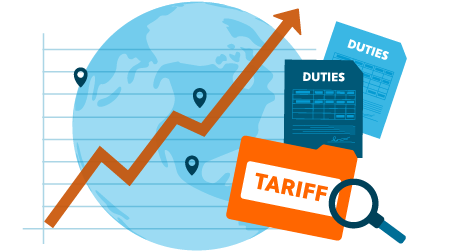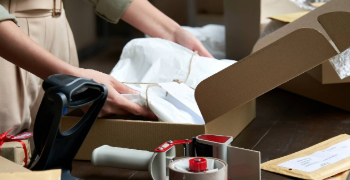
De minimis exemption changes are coming: Is your business ready?
This post has been updated to reflect new developments. Attend our webinar series, Trade and Tariff Tuesdays, to hear Avalara experts discuss global trade issues and their business implications.
The de minimis exemption for products of China and Hong Kong will end effective May 2, 2025, at 12:01 a.m. ET. Read on for more information or jump to the sections that interest you most:
- What is the de minimis exemption for customs duties?
- What are Trump’s plans for the de minimis exemption?
- Why would the U.S. change the de minimis exemption?
- How does CBP currently process Section 321 Entries?
- How will Section 321 Entries change under Trump?
- How will changing de minimis impact ecommerce businesses?
What is the de minimis exemption for customs duties?
The de minimis exemption allows many goods valued at or under $800 (per person, per day) to enter the United States exempt from duty and import taxes. De minimis is authorized under Section 321(a)(2)(c) of the Tariff Act of 1930, so these imports are often called Section 321 Entries.
Roughly 100 countries/territories have de minimis thresholds, but the U.S. threshold is by far the most generous. Congress raised the de minimis threshold from $200 to $800 (per person per day) in March 2016. The $800 value is based on the aggregate fair retail value in the country of shipment.
There were more than 1.36 billion de minimis shipments in 2024. While most low-value imports are legitimate, “bad actors” are exploiting the expedited import process to smuggle illegal and harmful goods into the country. Changing the de minimis exemption could help stem the flow of illegal low-value imports into the U.S.
What are Trump’s plans for the de minimis exemption?
On February 1, 2025, President Donald J. Trump issued three separate executive orders eliminating the de minimis exemption for Canada, Mexico, and the People’s Republic of China effective February 4. The orders also imposed additional duties on all imports from Canada, Mexico, and China.
A lot has changed with tariff policies since then, as we explain in Chips, drugs, and steel: How to prepare for Trump tariffs. For this blog post, we’re focusing on the end of duty-free de minimis.
On February 3, Trump paused the elimination of de minimis for Canada and Mexico until March 4, 2025, to allow time for negotiations. On March 2, he issued new executive orders keeping the de minimis exemptions for Canada and Mexico until “adequate systems are in place to fully and expeditiously process and collect tariff revenue” on de minimis shipments.
Since then, there’s been little to no talk of ending de minimis for Canada and Mexico.
The president allowed the de minimis exemption to cease for China on February 4. But he paused the tariffs on de minimis shipments from China on February 5 because United States Customs and Border Protection (CBP) needed time to prepare to process and collect tariffs expediently.
CBP has been preparing. Per an executive order dated April 2, products of China and Hong Kong are not eligible for the de minimis exemption as of 12:01 a.m. ET on May 2, 2025.
For more details, read How to handle U.S.-China tariffs and the eventual end of de minimis.
Why would the U.S. change the de minimis exemption?
While in theory “CBP monitors/reviews shipments the same regardless of value,” in reality, customs officials have struggled to keep up with the tsunami of low-value imports arriving in the U.S. each day.
At New York’s John F. Kennedy International Airport alone, the entry point for 25% of all de minimis shipments, CBP often receives and processes between 750,000 and 1 million de minimis shipments each day. Nationwide, CBP daily processes close to 4 million de minimis shipments.
To put these figures into perspective, CBP processed approximately 139 million de minimis transactions in 2015, when the de minimis threshold was a quarter of what it is today.
At certain points of entry, the volume of low-value shipments is overwhelming customs officials. Yet CBP does scrutinize many low-value imports, and in doing so has discovered plenty of illegal goods: fentanyl and drug-making paraphernalia; counterfeit goods; smuggled beef, pork, and poultry declared as footwear and jackets; textiles produced by forced labor; and weapons hidden inside chocolate, to name just a few.
To “stop the abuse of the de minimis exemption,” the Biden White House announced a plan in September 2024 that included:
- Imposing tariffs on goods that injure or threaten domestic industry or national security
- Requiring additional data for de minimis shipments
- Requiring importers to file electronic certificates of compliance with CBP and the Consumer Product Safety Commission (CPSC) at the point of entry
The Biden administration also called on Congress to “reform the de minimis exemption comprehensively.” It was particularly interested in stopping harmful drugs from illegally entering the U.S. and preventing imports of apparel and textile products made by forced labor (e.g., the Uyghurs in China).
The de minimis mantle was picked up by the Trump administration.
On January 20, 2025, the White House announced that “the Secretary of the Treasury, the Secretary of Commerce, the Secretary of Homeland Security, and the Senior Counselor for Trade and Manufacturing, in consultation with the United States Trade Representative, shall assess the loss of tariff revenues and the risks … from the current implementation of the … duty-free de minimis exemption … and shall recommend modifications as warranted to protect both the revenue of the United States and the public health by preventing unlawful importations.”
Recommendations were to be delivered to President Trump by April 1, 2025, and on April 2, the White House eliminated the $800 de minimis exemption altogether for China and Hong Kong. Affected low-value imports will be subject to tariffs and new customs processes starting May 2.
How does CBP process Section 321 Entries?
A few different customs entry processes are currently available for Section 321 Entries, including:
- Release from manifest process, an informal entry process with simplified documentation requirements and clearance procedures. This option is not available for shipments subject to the Partner Government Agencies (PGA) regulation.
- Entry Type 86, a more formal entry process suitable for all Section 321 shipments. This option is available for PGA shipments and low-value imports subject to other oversights.
Release from manifest process
The following information is required for shipments entering the country via a release from manifest entry:
- Country of origin of the merchandise
- Merchandise description (specific)
- Value, quantity, and shipping weight of goods
- Shipper name, address, and country
- Ultimate consignee name and address
The following information isn’t required but may be provided:
- Entry summary
- Harmonized Tariff Schedule of the United States codes (HTSUS codes, also called Harmonized System or HS codes)
Entry Type 86
The following information is required for shipments using Entry Type 86, or T86:
- Bill of lading or the air waybill number
- Consignee name and address
- Country of origin
- Entry number
- Fair retail value in the country of shipment
- Importer of record (IOR) number of the owner, purchaser, or broker (required when the shipment is subject to PGA data reporting requirements)
- Planned port of entry
- Quantity
- Shipper name, address, and country
- HTSUS code
T86 documents must be filed electronically through CBP’s Automated Commercial Environment (ACE) portal. Before February 15, 2024, importers had up to 15 days after arrival of the cargo to provide the necessary information. Today, documents are due before or upon reaching customs.
There’s yet another entry process for postal shipments.
Parcels arriving by mail
The documents required for low-value shipments sent by mail generally include:
- Customs declaration
- Invoice or bill of sale (or other statement showing the fair retail value in the country of shipment)
Qualifying low-value shipments sent through the mail are generally accepted without an entry and free from duty and import tax.
How have Section 321 Entries changed under Trump?
CBP guidance dated April 18 explains that products of the People’s Republic of China, including products of Hong Kong, are no longer eligible for the exemption from duty and certain taxes under Section 321. Starting May 2, 2025, such goods:
- Are not eligible for the de minimis exemption;
- Must be entered under an appropriate entry type, such as T11 or T01; and
- Will be subject to all applicable duties, taxes, and fees.
“Requests for de minimis entry and clearance for ineligible shipments will be rejected.”
Except for international mail shipments, the appropriate entry type must be made in the CBP’s Automated Commercial Environment (ACE) for low-value imports from China and Hong Kong. Paper entry forms or documents will not be accepted, and such products may not be entered using Entry Type 86.
For postal items containing low-value goods from China and Hong Kong, CBP will collect an ad valorem duty of 120% of the value of the shipment, or $100 per item starting May 2. The $100 duty will increase to $200 per item on June 1, 2025.
CBP will provide additional guidance via CSMS messages.
All low-value products of China and Hong Kong will require additional data — including the 10-digit tariff classification number (HTSUS or HTS codes).
“10-digit HTS codes are already required for a majority of clearance processes,” explains Shane Bogdan, Director of Cross-Border Sales at Avalara, “but not everyone is providing them, nor are they being classified accurately. In some instances, organizations may be just affixing four random digits (e.g., 0000) to the end of a 6-digit HS code to make it the required 10-digit code.”
More de minimis changes could be coming
On January 17, CBP proposed a new rule to exclude from the de minimis exemption all shipments containing products covered by tariffs imposed under Section 201 or Section 301 of the Trade Act of 1974, or Section 232 of the Trade Expansion Act of 1962. These sections govern products that injure or threaten domestic businesses or national security.
Low-value shipments arriving by mail would be allowed to use the enhanced entry process. The customs declaration and invoice would need to be submitted electronically and received by CBP no later than the date the merchandise departs from the country of posting. De minimis mail shipments are not eligible to use the basic entry process.
CPSC has also been working on a rule to prevent de minimis shipments from circumnavigating safety standards. Importers of consumer products would be required to file Certificates of Compliance (CoC) electronically with CBP and CPSC at the time of entry — including for de minimis shipments, which currently don’t require a CoC. The initial proposed rule was submitted in December 2023; it’s unclear where it stands today.
How will changing de minimis impact ecommerce businesses?
Delays and added costs are the two biggest potential fallouts of changing the de minimis import process.
Subjecting de minimis shipments to additional scrutiny will likely slow the process of clearing low-value, cross-border ecommerce packages. And CBP is increasing enforcement activity: It completed 71 audits in March 2025 that identified $310 million in duties and fees owed to the U.S. government — more than in January and February combined.
Ecommerce businesses shipping goods into the U.S. from other countries will therefore need to alert consumers of potential delays and plan accordingly.
Furthermore, FedEx and UPS have increased fees for low-value products from China and Hong Kong. Higher-value shipments are also affected: DHL has temporarily suspended the collection and shipping of business-to-consumer shipments to private individuals in the U.S. for products valued more than $800. And Hongkong Post won’t collect tariffs on behalf of the U.S. and will suspend shipments to the U.S.
With CBP cracking down on enforcement and President Trump keen on making last-minute de minimis tariff changes, ecommerce businesses should be proactive and do all they can to streamline cross-border sales. Assigning the correct 10-digit HTS code to all low-value imports can help, as can confirming all imports comply with current trade restrictions.
“Accurate and complete HTS codes ensure streamlined processing through customs, increase trade visibility and efficiency, and help maintain the integrity of the supply chain,” says Bogdan. Given the heightened focus on compliance, international sellers that proactively adopt cross-border compliance solutions should be in the best position to avoid being held up at customs.
Avalara has a portfolio of services to help businesses comply with de minimis exemption requirements and trade restrictions. These include our HS code classification services: Automated Tariff Code Classification, Self-Serve Tariff Code Classification, and Managed Tariff Code Classification.
Schedule a call today for more details.

Simplify cross-border tariff compliance with automation
Stay ahead of changing trade regulations with automated tariff code classification and duty calculations
Stay up to date
Sign up for our free newsletter and stay up to date with the latest tax news.












